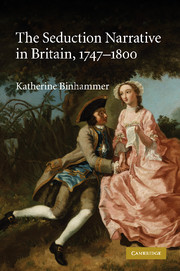Book contents
- Frontmatter
- Contents
- Acknowledgments
- Introduction
- 1 Knowing love: The epistemology of Clarissa
- 2 The whore's love or the Magdalen's seduction
- 3 After knowledge: Married heroines and seduction
- 4 Seduction in street literature
- 5 Melodramatic seduction: 1790s fiction and the excess of the real
- Notes
- Bibliography
- Index
5 - Melodramatic seduction: 1790s fiction and the excess of the real
Published online by Cambridge University Press: 18 February 2010
- Frontmatter
- Contents
- Acknowledgments
- Introduction
- 1 Knowing love: The epistemology of Clarissa
- 2 The whore's love or the Magdalen's seduction
- 3 After knowledge: Married heroines and seduction
- 4 Seduction in street literature
- 5 Melodramatic seduction: 1790s fiction and the excess of the real
- Notes
- Bibliography
- Index
Summary
In the decades following the publication of Clarissa, as this book has traced, the seduction plot turned the problem of how to read the new signs of love into narrative form, telling many different stories about women's failure to recognize both internal and external significations. By representing a female-centered semiotics of love as uncharted territory, these tales did not always already contain the end of a restrictive passive femininity nor did their stories dictate a proper domesticated desire. The 1790s, however, mark a shift in seduction's story and my claim is no longer entirely tenable. Culture's obsession with the seduction plot disappears at the beginning of the nineteenth century and this chapter argues that it did so because it takes on a static meaning within the political wars of the 1790s, one that replaces affective truth with political truth as the problem that the narrative promises to resolve. The revolutionary politics of the 1790s changed seduction's significations, displacing its epistemological pursuit of how a woman knows her own heart into a political allegory that presupposes a singular and fixed understanding of that heart. Through an analysis of four feminist novels from the end of the century – Elizabeth Inchbald's Nature and Art (1796), Mary Wollstonecraft's Wrongs of Woman (1798), Mary Hays's Victim of Prejudice (1799) and Amelia Opie's Father and Daughter (1801) – I argue that their melodramatic tone exposes the static understanding of female sexuality that was becoming dominant through seduction's political tellings.
- Type
- Chapter
- Information
- The Seduction Narrative in Britain, 1747–1800 , pp. 138 - 175Publisher: Cambridge University PressPrint publication year: 2009



